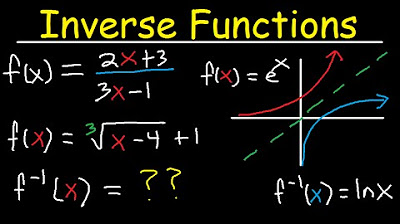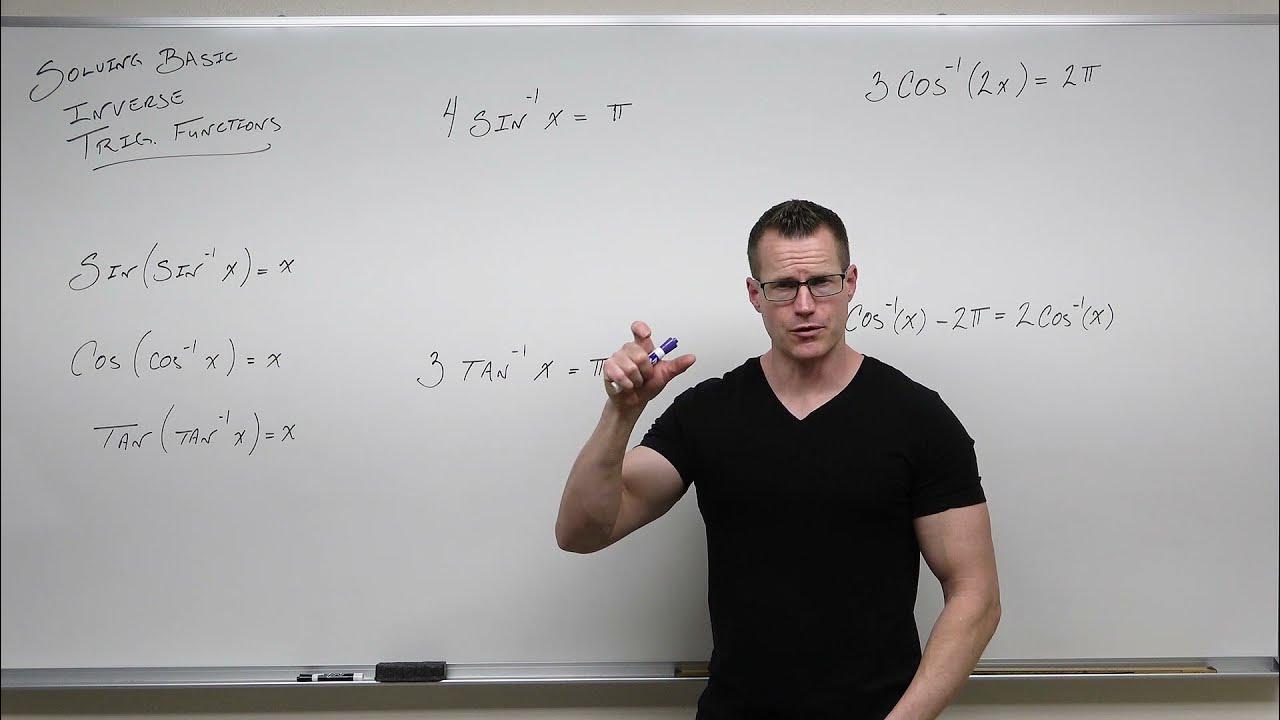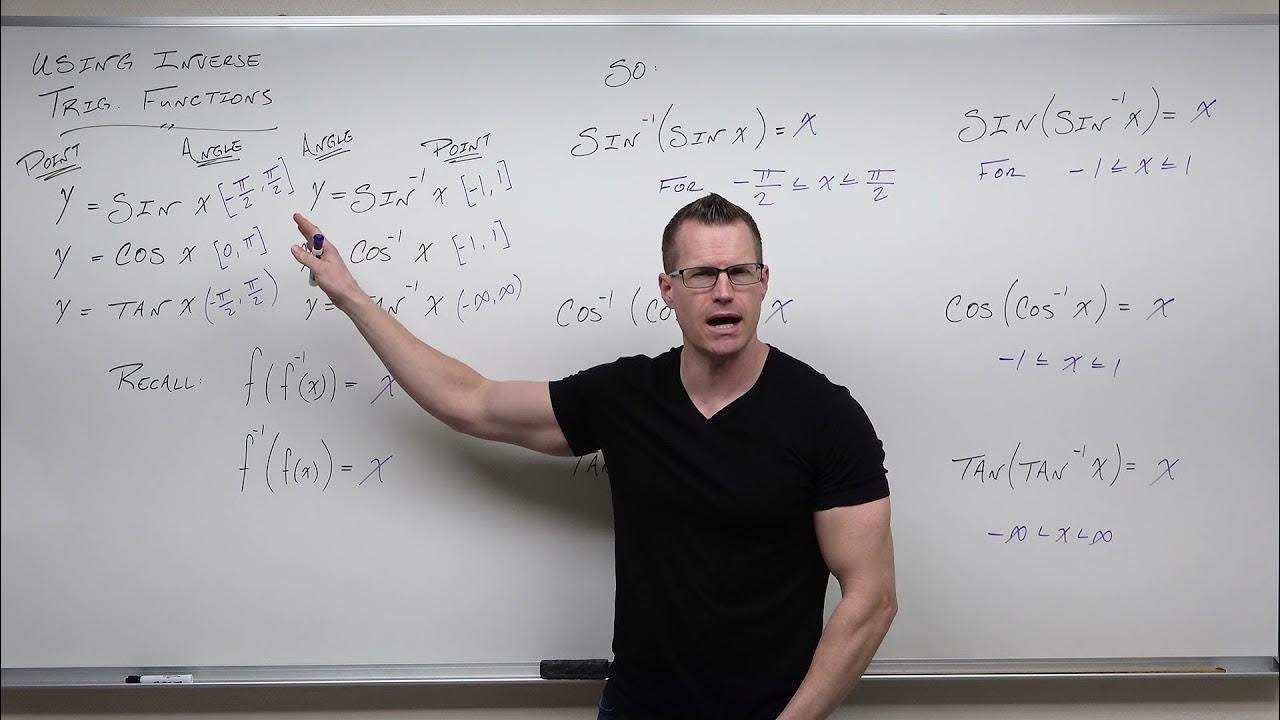How to Find Inverse Trigonometric Functions (Precalculus - Trigonometry 19)
TLDRThe video script is an educational guide on finding inverse trigonometric functions. It emphasizes the importance of domain restriction to ensure a one-to-one function, which is necessary for finding an inverse. The process involves identifying the function, determining its domain and range, and then using these to find the inverse function. The script provides a step-by-step approach for sine, cosine, and tangent functions, including how to handle vertical and horizontal shifts, and how to solve for the inverse function algebraically. It concludes with the understanding that the domain and range switch places for the inverse function and offers a method to check the work by composing the function with its inverse.
Takeaways
- 📐 **Inverse Trigonometric Functions**: To find inverse trigonometric functions, the domain must be restricted to ensure a one-to-one relationship between the input and output values.
- 🔢 **Domain and Range Reversal**: When finding an inverse function, the domain and range of the original function are reversed. The domain of the original function becomes the range of the inverse, and vice versa.
- 🔁 **Function Notation**: Begin by replacing the function notation (e.g., f(x) or g(x)) with y, then swap y with x and solve for y to find the inverse function.
- 🧮 **Solving for Inverses**: To solve for an inverse, isolate the trigonometric function and apply the inverse function, which effectively undoes the original function.
- 📉 **Domain Identification**: Identify the function and its domain to find the values for which the inverse function exists. This typically involves solving inequalities.
- 📈 **Range Determination**: The range of the original function can be used to determine the smallest and largest possible values of the function, which helps in finding the range of the inverse function.
- 🚫 **Exclusions in Domain**: Certain values may need to be excluded from the domain to maintain the one-to-one property of the function, such as excluding vertical asymptotes for tangent.
- 🔄 **Function Composition**: When composing a function with its inverse, the result should simplify to the original input (x), provided the domain is correctly identified.
- 📋 **Interval Notation**: Interval notation is used to express the domain and range of functions and their inverses, which is particularly useful for mathematical operations and clarity.
- ⏲️ **Continuous Function**: The function within the domain must be continuous to ensure that every possible value within the range can be obtained from the inverse function.
- 🔀 **Switching Domain and Range**: After finding the inverse function, remember to switch the domain and range from the original function to the inverse function.
Q & A
What is the main topic of the video?
-The main topic of the video is finding inverse trigonometric functions and understanding the concepts of domain and range when dealing with inverse functions.
Why do we need to restrict the domain for sine, cosine, and tangent functions?
-We need to restrict the domain for sine, cosine, and tangent functions to ensure that the function is one-to-one, which is a requirement for a function to have an inverse.
What is the domain of the sine function for which we can find an inverse?
-The domain of the sine function for which we can find an inverse is from -π/2 to π/2 inclusive.
What is the process of finding the domain and range for an inverse function?
-To find the domain and range for an inverse function, first identify the function and its domain. Then, find the smallest and largest values the function can take, which will give you the range. For the inverse function, the domain and range are reversed.
How does the process of finding the inverse of a function work?
-To find the inverse of a function, you replace the function notation (like f(x)) with y, then swap y and x, and solve for y. This process effectively undoes the original function, hence finding the inverse.
What is the domain of the tangent function for which we can find an inverse?
-The domain of the tangent function for which we can find an inverse is from -π/2 to π/2, but not including the endpoints.
What is the range of the sine function?
-The range of the sine function is from -1 to 1, inclusive.
How do you find the domain of a function like 5 sine x + 2?
-To find the domain of a function like 5 sine x + 2, you first identify the trigonometric function (sine) and its required domain for inverse (-π/2 to π/2). Then, you solve for x such that the function's argument falls within this domain, taking into account any transformations applied to the function.
What is the range of the function 5 sine x + 2?
-The range of the function 5 sine x + 2 is from -3 to 7, inclusive. This is determined by multiplying the maximum and minimum values of the sine function (-1 and 1, respectively) by 5 and then adding 2.
What is the general process for solving for the inverse of a trigonometric function?
-The general process involves: 1) Replacing the function notation with y, 2) Swapping y and x, 3) Isolating the trigonometric function using algebraic operations, 4) Applying the inverse trigonometric function, and 5) Solving for y to get the inverse function.
Why is it important to identify the domain and range before finding the inverse function?
-Identifying the domain and range before finding the inverse function is important because it ensures that the function is one-to-one within the specified domain, which is necessary for the existence of an inverse. It also simplifies the process by allowing you to directly apply the domain and range of the original function to the inverse.
How does the domain and range of a function relate to its inverse?
-The domain and range of a function are switched for its inverse. The domain of the original function becomes the range of the inverse function, and the range of the original function becomes the domain of the inverse function.
Outlines
📚 Introduction to Inverse Trigonometric Functions
This paragraph introduces the topic of finding inverse trigonometric functions. It emphasizes the importance of restricting the domain for sine, cosine, and tangent functions to create a one-to-one relationship necessary for finding an inverse. The speaker also reminds viewers of the domains for these functions: sine from -π/2 to π/2, cosine from 0 to π, and tangent from -π/2 to π/2 excluding the endpoints. The process of finding the domain and range of the original function is explained as a preliminary step, as these will become the range and domain of the inverse function, respectively.
🔢 Determining the Domain and Range for Inverse Sine
The paragraph explains how to determine the domain and range for the inverse sine function. It discusses the concept of the smallest and largest possible values for the sine function and how these values, when scaled and shifted, give the range for the inverse function. The process involves considering the continuous nature of the sine function and using inequality notation to find the domain. The range is found by considering the maximum and minimum values of the sine function and applying the transformations to these values.
🔁 Finding the Inverse Function and Its Domain and Range
This section details the steps to find the inverse of a function, specifically focusing on the inverse sine function. It outlines the process of replacing the function notation with 'y', then swapping 'y' and 'x', and solving for 'y'. The importance of isolating the function and using the appropriate inverse function is highlighted. The paragraph also explains how the domain and range switch for the inverse function and emphasizes the need to ensure the domain is set correctly for the inverse to be valid.
🧮 Domain and Range for Inverse Tangent Function
The speaker provides an example of finding the domain and range for the inverse tangent function. It explains that the domain for the tangent function must be restricted to between -π/2 and π/2, not inclusive, to maintain a one-to-one relationship. The process involves solving compound inequalities to find the domain. The range for the inverse tangent function is all real numbers, as the tangent function ranges from negative infinity to positive infinity. The paragraph concludes with the steps to solve for the inverse function, emphasizing the need to isolate the tangent function and use the inverse tangent correctly.
🔃 Composing the Inverse Function for Tangent
This paragraph focuses on composing the inverse function for the tangent function. It describes the process of replacing the function notation with 'y', switching 'y' and 'x', and solving for 'y'. The composition of the inverse tangent function with the original function is shown to simplify to 'y + 1', demonstrating the cancellation property of inverse functions. The domain and range for the inverse tangent function are discussed, with the domain being all real numbers and the range being the set values that the original function's domain allowed.
📐 Working with Cosine Function and Its Inverse
The paragraph deals with the cosine function and its inverse. It starts by identifying the domain necessary for the cosine function to be one-to-one, which is between 0 and π. The domain is then found by solving compound inequalities. The range of the cosine function is discussed, with the largest value being 1 and the smallest being -1. The process of finding the inverse function involves isolating the cosine function and applying the inverse cosine function. The final inverse function is presented, along with the understanding that the domain and range for the inverse function are derived from the range and domain of the original function, respectively.
🔄 Finalizing the Inverse Function and Understanding Its Properties
The final paragraph summarizes the process of finding the inverse function, specifically for the cosine function. It emphasizes the importance of identifying the correct domain and range for the original function to ensure the inverse function is valid. The domain of the inverse function is the range of the original function, and vice versa. The paragraph also highlights the need to use inequality notation to clearly understand the input and output values for the inverse function. It concludes with a reminder that inverse functions are used to undo the actions of the original function and that they are only defined for one-to-one portions of the original function.
Mindmap
Keywords
💡Inverse Trigonometric Functions
💡Domain
💡Range
💡One-to-One Function
💡Vertical Shift
💡Sine Function
💡Cosine Function
💡Tangent Function
💡Interval Notation
💡Compound Inequalities
💡Inverse Function Composition
Highlights
The video discusses finding inverse trigonometric functions and emphasizes the importance of domain restriction for sine, cosine, and tangent to create a one-to-one function.
For sine, the domain must be between -π/2 and π/2 inclusive; for cosine, it's between 0 and π inclusive; and for tangent, it's between -π/2 and π/2 exclusive.
When finding an inverse function, the first step is to identify the domain and range of the original function, as they become reversed for the inverse.
The concept of x is to be considered in the broadest sense, meaning it must fall within the specific interval for the trigonometric function in question.
The range for sine and cosine is between -1 and 1, while for tangent, it's from negative infinity to positive infinity.
Finding the domain involves identifying the trigonometric function and ensuring that the inputs fall within the one-to-one portion of the function's domain.
For the range, the smallest and largest possible values of the function are considered, which correspond to the endpoints of the sine function's range.
The process of finding the inverse function involves replacing the function notation with y, then swapping y and x, and solving for y.
Isolating the trigonometric function and undoing the operations is key to solving for y and finding the inverse function.
The composition of an inverse function and its root function will always cancel out, simplifying to y, provided the domain is correctly identified.
The domain and range of the inverse function are switched from the original function, with the input of the original function becoming the output of the inverse.
The video provides a step-by-step guide to finding the inverse of a function, including the application of domain and range restrictions.
The video includes an example of finding the inverse of a function involving the sine function, demonstrating how to apply the concepts discussed.
The process is further illustrated with examples involving the tangent and cosine functions, showing how to handle different trigonometric functions.
The video emphasizes the importance of understanding the domain and range of the original function to correctly find the inverse function.
The video concludes with a summary of the steps for finding inverse functions and a preview of solving basic equations with inverse functions in the next video.
Transcripts
Browse More Related Video

Inverse Functions - Domain & range- With Fractions, Square Roots, & Graphs

How to Solve Basic Inverse Trigonometric Functions (Precalculus - Trigonometry 20)

Inverse Functions

How to Use Inverse Trigonometric Functions (Precalculus - Trigonometry 18)

Finding Inverse Functions (Precalculus - College Algebra 51)

Function inverses example 2 | Functions and their graphs | Algebra II | Khan Academy
5.0 / 5 (0 votes)
Thanks for rating: